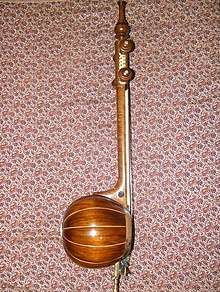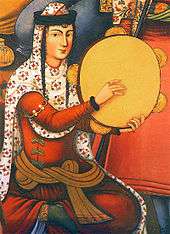Kamancheh
The kamancheh (also kamānche or kamāncha) (Persian: کمانچه, Kurdish: کەمانچە ,Kemançe) is an Iranian bowed string instrument used in Kurdish music[1] and Persian music[2] but also used in Azerbaijani music. The kamanchech is related to the rebab which is the historical ancestor of the kamancheh and the bowed Byzantine lyra.[3] The strings are played with a variable-tension bow. It is widely used in the classical music of Iran, Azerbaijan, Kurdistan, Uzbekistan and Turkmenistan with slight variations in the structure of the instrument.[4]
.jpg) Woman playing the kamancheh in the painting "Musical banquet" by Ibrahim Jabbar-Beik (1923-2002) | |
| String instrument | |
|---|---|
| Other names | Kamancha, Kamanche, Kemancheh, Kamanjah, Kabak kemane |
| Classification | Bowed Strings |
| Playing range | |
| g3-e7 | |
| Related instruments | |
| |
| Musicians | |
| |
| Builders | |
| |
| Art of crafting and playing with Kamantcheh/Kamancha, a bowed string musical instrument | |
|---|---|
UNESCO Intangible Cultural Heritage | |
| Country | Azerbaijan and Iran |
| Reference | 1286 |
| Inscription history | |
| Inscription | 2017 (13th session) |

In 2017, the art of crafting and playing with Kamantcheh/Kamancha was included into the UNESCO Intangible Cultural Heritage Lists.
Name and etymology
The word "kamancheh" means "little bow" in Persian (kæman, bow, and -cheh, diminutive).[5] The Turkish word kemençe is borrowed from Persian, with the pronunciation adapted to Turkish phonology. It also denotes a bowed string instrument, but the Turkish version differs significantly in structure and sound from the Persian kamancheh. There is also an instrument called kabak kemane literally "pumpkin-shaped bow instrument" used in Turkish music which is only slightly different from the Iranian kamancheh.[6]
Structure
The kamanche has a long neck including fingerboard which kamancheh maker shapes it as a truncated inverse cone for easy bow moving in down section, peg box in both side of which four pegs are placed, and finial[7] Traditionally kamanchehs had three silk strings, but modern instruments have four metal strings. Kamanchehs may have highly ornate inlays and elaborate carved ivory tuning pegs. The body has a long upper neck and a lower bowl-shaped resonating chamber made from a gourd or wood, usually covered with a membrane made from the skin of a lamb, goat or sometimes a fish, on which the bridge is set. From the bottom protrudes a spike to support the kamancheh while it is being played, hence in English the instrument is sometimes called the spiked fiddle. It is played sitting down held like a cello though it is about the length of a viol. The end-pin can rest on the knee or thigh while the player is seated in a chair.
Kamancheh is usually tuned like an ordinary violin (G, D, A, E).
Notable kamancheh players
- Habil Aliyev
- Mehdi Bagheri
- Ali-Asghar Bahari
- Mark Eliyahu
- Kayhan Kalhor
- Ardeshir Kamkar
- Sayat-Nova
See also
- List of bowed stringed instruments
- Music of Iran
- Byzantine lira
- Haegeum
- Rebab
- Silk Road Ensemble
References
- "Iranian Kurdish musician wins prestigious award". Kurdistan24. 19 August 2019. Retrieved 24 March 2020.
- Global Minstrels: Voices of World Music. Elijah Wald. 2012. p. 227. ISBN 9781135863685.
- "Iranian string instrument 'Kamancheh' to be inscribed on UNESCO list". 11 April 2015. Retrieved 1 May 2015.
- "Pastimes of Central Asians. Musicians. A Man Practising the Kamancha, a Long-necked Stringed Instrument". World Digital Library. Retrieved 14 May 2014.
- loghatnaameh.com. "کمانچه – پارسی ویکی". Archived from the original on 2008-10-17.
- "Kabak kemane ve Kemancha hakkında rehber". Archived from the original on 2017-12-14. Retrieved 2014-07-05.
- Ch, R. A. M.; 51, Rakausika राम च (2013-03-08). "The Masters of Kamanche". A World,s Heritage Of Native Music. Retrieved 2017-05-16.CS1 maint: numeric names: authors list (link)
External links
| Wikimedia Commons has media related to Kamancheh. |



